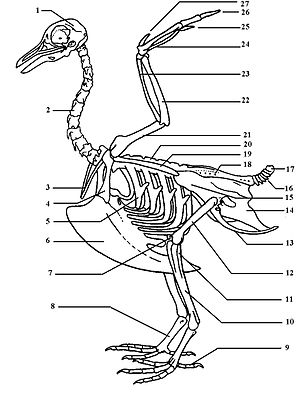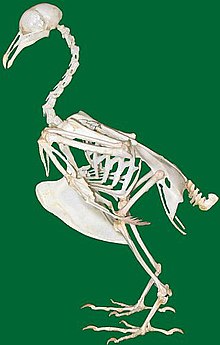Bird skeleton
The skeleton of the birds is particularly light compared to the skeleton of the other vertebrates , since some bones are air- filled (pneumatized) due to protuberances in the air sacs .
skull
The skull has a very large orbit (eye socket). A kind of push rod ( os jugale and quadratojugale ) can be used to fold the upper jaw upwards, in addition to moving the lower jaw downwards .
Spine and trunk

1 skull (cranium)
2 cervical vertebrae
3 fork bone (furcula)
4 raven bone (coracoid)
5 rib
6 sternum ridge (carina sterni)
7 kneecap (patella)
8 tarsometatarsus
9 first toe
10 tibiotarsus
11 calf bone (fibula)
12 femur
13 pubic bone
14 ischium
15 iliac bone
16 tail vertebrae
17 pygostyle
18 synsacrum
19 shoulder blade
20 notary
21 humerus
22 ulna
23 spoke (radius)
24 carpometacarpus
25 minor digit
26 major digit
27 thumb or alula (digitus alulae)
The neck of the birds is very flexible and long, because there are 10 to 31 ( Black Swan ), usually 14 or 15 cervical vertebrae.
The stiffened torso skeleton forms a solid unit.
- It consists of 3 to 10 thoracic vertebrae that are not very mobile. In different groups they are fused into a bone stick, the notary .
- The thoracic vertebrae carry ribs that are connected to the large sternum and thus form the rib cage . Birds' ribs have no costal cartilage, but are completely bony. The anterior ribs have hook-shaped, backward-directed processes ( uncinate processes ) that stabilize the thorax and play a role in inhalation. There are no hooked appendages in the defense birds and the emu .
- The posterior thoracic vertebrae and the lumbar vertebrae are fused to one another to form the synsacrum , this in turn with the pelvis .
- The last caudal vertebrae are fused together to form a large pygostyle with tail feathers.
- At the sternum (breastbone) is the strong flight muscles on. In all birds capable of flying it has a high sternum ridge ( Carina or Crista sterni ), which increases the area of attachment.
Shoulder girdle
The shoulder girdle consists of:
- the coracoid ( raven bone ), which runs from the sternum to the front-up-side,
- the paired collarbones in front of the two halves of the body, which are fused together to form the furcula ( forkbone ) (the forkbone never breaks in half, so that a larger and a smaller piece are always created. In some cultures, the person who receives the larger piece has , a wish free, in English this bone is called wishbone ),
- the narrow shoulder blade ( scapula ).
wing
The wing skeleton (→ wing ) consists of
- the upper arm bone (humerus)
- the two forearm bones ulna (ulna) and radius (radius), whereby the ulna, in contrast to mammals , is the stronger bone. The arms are attached to it.
- the strongly changed hand area
- two carpal bones ( os carpi radiale and ulnare ),
- a carpometacarpus made of fused carpal and metacarpal bones,
- only three fingers left : digitus major , digitus minor , digitus alulae . The digitus alulae forms the bony basis of the corner wing , which functions like a landing flap on an airplane. Most birds have no claws on their fingers, one exception being e.g. B. the bouquet . In addition, the chicks of the Hoatzin have claws on all three fingers that are strongly reminiscent of the Archeopteryx. However, they regress in adulthood.
The flight feathers attach to the forearm and hand. A distinction is made between arm and hand swing .
Hind limbs
The pool is like the mammal of the ilium (iliac), ischium (ischial) and pubis (pubic bone). It is fused with the synsacrum and has three openings for nerves and blood vessels to pass through . With the exception of the ostrich and rhea , it is open at the bottom, so there is no pelvic symphysis.
The leg skeleton consists of
- the (as with a seated person) forward-downward facing femur (thigh bone),
- the lower leg bone with the shin and very thin fibula , whereby the shin is fused with the upper tarsal bones and is therefore referred to as the tibiotarsus ,
- the foot , and this in turn off
- the tarsometatarsus (running bone) from fused tarsal and metatarsal bones. The spur ( calcar metatarsale ) of male chickens is bony supported by a backward-directed bony process,
- the toe bone, with the first toe usually pointing backwards and the front toes (= toes No. II, III and IV) pointing forward. Some species have only 3 toes, the ostrich only 2. The toes have claws.
literature
- Franz-Viktor Salomon , Maria-Elisabeth Krautwald-Junghanns : Anatomy of the birds. In: FV. Salomon et al. (Ed.): Anatomy for veterinary medicine . 2nd ext. Edition. Enke, Stuttgart 2008, ISBN 978-3-8304-1075-1 , pp. 754-814.
- G. Hummel: anatomy and physiology of birds . Eugen Ulmer Verlag, Stuttgart 2000, ISBN 3-8001-2735-0 .

